SECTION III
Number of questions: 55
DIRECTIONS for questions 111 to 120: Each question consists of five statements followed by options consisting of three statements put together in a specific order. Choose the option which indicates a valid argument, that is, where the third statement is a conclusion drawn from the preceding two statements.
Example:
- All cigarettes are hazardous to health.
- Brand X is a cigarette.
- Brand X is hazardous to health.
ABC is a valid option, where statement C can be concluded from statements A and B.
111.
A. All software companies employ knowledge workers.
B. Tara Tech employs knowledge workers.
C. Tara Tech is a software company.
D. Some software companies employ knowledge workers.
E. Tara Tech employs only knowledge workers.
1. ABC
2. ACB
3. CDB
4. ACE
112.
A. Traffic congestion increases carbon monoxide in the environment.
B. Increase in carbon monoxide is hazardous to health.
C. Traffic congestion is hazardous to health.
D. Some traffic congestion does not cause increased carbon monoxide.
E. Some traffic congestion is not hazardous to health.
1. CBA
2. BDE
3. CDE
4. BAC
113.
A. Apples are not sweets.
B. Some apples are sweet.
C. All sweets are tasty.
D. Some apples are not tasty.
E. No apple is tasty.
1. CEA
2. BDC
3. CBD
4. EAC
114.
A. Some towns in India are polluted.
B. All polluted towns should be destroyed.
C. Town Meghana should be destroyed.
D. Town Meghana is polluted.
E. Some towns in India should be destroyed.
1. BDE
2. BAE
3. ADE
4. CDB
115.
A. No patriot is a criminal.
B. Bundledas is not a criminal.
C. Bundledas is a patriot.
D. Bogusdas is not a patriot.
E. Bogusdas is a criminal.
1. ACB
2. ABC
3. ADE
4. ABE
116.
A. Ant eaters like ants.
B. Boys are ant eaters.
C. Balaram is an ant eater.
D. Balaram likes ants.
E. Balaram may eat ants.
1. DCA
2. ADC
3. ABE
4. ACD
117.
A. All actors are handsome.
B. Some actors are popular.
C. Ram is handsome.
D. Ram is a popular actor.
E. Some popular people are handsome.
1. ACD
2. ABE
3. DCA
4. EDC
118.
A. Modern industry is technology driven.
B. BTI is a modern industry.
C. BTI is technology driven.
D. BTI may be technology driven.
E. Technology driven industry is modem.
1. ABC
2. ABD
3. BCA
4. EBC
119.
A. All Golmal islanders are blue coloured people.
B. Some smart people are not blue coloured people.
C. Some babies are blue coloured.
D. Some babies are smart.
E. Some smart people are not Golmal islanders.
1. BCD
2. ABE
3. CBD
4. None of the above
120.
A. MBAs are in great demand.
B. Ram and Sita are in great demand.
C. Ram is in great demand.
D. Sita is in great demand.
E. Ram and Sita are MBAs.
1. ABE
2. ECD
3. AEB
4. EBA
DIRECTIONS for questions 121 to 124: Each question has a main statement followed by four statements labelled A, B, C and D. Choose the ordered pair of statements where the first statement implies the second, and the two statements are logically consistent with the main statement.
121. Either the orangutan is not angry, or he frowns upon the world.
A. The orangutan frowns upon the world.
B. The orangutan is not angry.
C. The orangutan does not frown upon the world.
D. The orangutan is angry.
1. CB only
2. DA only
3. AB only
4. CB and DA
122. Either Ravana is a demon, or he is a hero.
A. Ravana is a hero.
B. Ravana is a demon.
C. Ravana is not a demon.
D. Ravana is not a hero.
1. CD only
2. BA only
3. CD and BA
4. DB and CA
123. Whenever Rajeev uses the internet, he dreams about spiders.
A. Rajeev did not dream about spiders.
B. Rajeev used the internet.
C. Rajeev dreamt about spiders.
D. Rajeev did not use the internet.
1. AD
2. DC
3. CB
4. DA
124. If I talk to my professors, then I do not need to take a pill for headache.
A. I talked to my professors.
B. I did not need to take a pill for headache.
C. I needed to take a pill for headache.
D. I did not talk to my professors.
1. AB only
2. DC only
3. CD only
4. AB and CD
DIRECTIONS for questions 125 to 134: Each question has a set of four statements. Each statement has three segments. Choose the alternative where the third segment in the statement can be logically deduced using both the preceding two, but not just from one of them.
125.
A. No cowboys laugh. Some who laugh are sphinxes. Some sphinxes are not cowboys.
B. All ghosts are fluorescent. Some ghosts do not sing. Some singers are not fluorescent.
C. Cricketers indulge in swearing. Those who swear are hanged. Some who are hanged are not cricketers.
D. Some crazy people are pianists. All crazy people are whistlers. Some whistlers are pianists.
1. A and B
2. C only
3. A and D
4. D only
126.
A. All good people are knights. All warriors are good people. All knights are warriors.
B. No footballers are ministers. All footballers are tough. Some ministers are players.
C. All pizzas are snacks. Some meals are pizzas. Some meals are snacks.
D. Some barkers are musk-deer. All barkers are sloth bears. Some sloth bears are musk-deer.
1. C and D
2. B and C
3. A only
4. C only
127.
A. Dinosaurs are pre-historic creatures. Water-buffaloes are not dinosaurs. Water-buffaloes are not pre- historic creatures.
B. All politicians are frank. No frank people are crocodiles. No crocodiles are politicians.
C. No diamond is quartz. No opal is quartz. Diamonds are opals.
D. All monkeys like bananas. Some GI Joes like bananas. Some GI Joes are monkeys.
1. C only
2. B only
3. A and D
4. B and C
128.
A. All earthquakes cause havoc. Some landslides cause havoc. Some earthquakes cause landslides.
B. All glass things are transparent. Some curios are glass things. Some curios are transparent.
C. All clay objects are brittle. All XY are clay objects. Some XY are brittle.
D. No criminal is a patriot. Ram is not a patriot. Ram is a criminal.
1. D only
2. B only
3. C and B
4. A only
129.
A. MD is an actor. Some actors are pretty. MD is pretty.
B. Some men are cops. All cops are brave. Some brave people are cops.
C. All cops are brave. Some men are cops. Some men are brave.
D. All actors are pretty; MD is not an actor; MD is not pretty.
1. D only
2. C only
3. A only
4. B and C
130.
A. All IIMs are in India. No BIMs are in India. No IIMs are BIMs.
B. All IIMs are in India. No BIMs are in India. No BIMs are IIMs.
C. Some IIMs are not in India. Some BIMs are not in India. Some IIMs are BIMs.
D. Some IIMs are not in India. Some BIMs are not in India. Some BIMs are IIMs.
1. A and B
2. C and D
3. A only
4. B only
131.
A. Citizens of Yes Islands speak only the truth. Citizens of Yes Islands are young people. Young people speak only the truth.
B. Citizens of Yes Islands speak only the truth. Some Yes Islands are in the Atlantic. Some citizens of Yes Islands are in the Atlantic.
C. Citizens of Yes Islands speak only the truth. Some young people are citizens of Yes Islands. Some young people speak only the truth.
D. Some people speak only the truth. Some citizens of Yes Islands speak only the truth. Some people who speak only the truth are citizens of Yes Islands.
1. A only
2. B only
3. C only
4. D only
132.
A. All mammals are viviparous. Some fish are viviparous. Some fish are mammals.
B. All birds are oviparous. Some fish are not oviparous. Some fish are birds.
C. No mammal is oviparous. Some creatures are oviparous and some are not. Some creatures are not mammals.
D. Some creatures are mammals. Some creatures are viviparous. Some mammals are viviparous.
1. A only
2. B only
3. C only
4. D only
133.
A. Many singers are not writers. All poets are singers. Some poets are not writers.
B. Giants climb beanstalks. Some chicken do not climb beanstalks. Some chicken are not giants.
C. All explorers live in snowdrifts. Some penguins live in snowdrifts. Some penguins are explorers.
D. Amar is taller than Akbar. Anthony is shorter than Amar. Akbar is shorter than Anthony.
1. A only
2. B only
3. B and C
4. D only
134.
A. A few farmers are rocket scientists. Some rocket scientists catch snakes. A few farmers catch snakes.
B. Poonam is a kangaroo. Some kangaroos are made of teak. Poonam is made of teak.
C. No bulls eat grass. All matadors eat grass. No matadors are bulls.
D. Some skunks drive Cadillacs. All skunks are polar bears. Some polar bears drive Cadillacs.
1. B only
2. A and C
3. C only
4. C and D
DIRECTIONS for questions 135 to 138: These questions are based on the situation given below:
The figure below presents sales and net profit, in Rs. Crores, of IVP Ltd for the five years from 199495 to 1998-99. During this period, the sales increased from Rs.100 Crores to Rs. 680 Crores. Correspondingly, the net profit increased from Rs. 2.2 Crores to Rs. 12 Crores. Net profit is defined as the excess of sales over total costs.

135. The highest percentage of growth in sales, relative to the previous year, occurred in
1. 1995-96
2. 1996-97
3. 1997-98
4. 1998-99
136. The highest percentage growth in net profit, relative to the previous year, was achieved in
1. 1998-99
2. 1997-98
3. 1996-97
4. 1995-96
137. Defining profitability as the ratio of net profit to sales, IVP Ltd. recorded the highest profitability in
1. 1998-99
2. 1997-98
3. 1994-95
4. 1996-97
138. With profitability as defined in question 137, it can be concluded that
1. Profitability is non-decreasing during the five years from 1994-95 to 1998-99.
2. Profitability is non-increasing during the five years from 1994-95 to 1998-99.
3. Profitability remained constant during the five years from 1994 - 95 to 1998 -99.
4. None of the above.
DIRECTIONS for questions 139 to 144: Consider the information provided in the figure below relating to India's foreign trade in 1997-98 and the first eight months of 1998-99. Total trade with a region is defined as the sum of exports to and imports from that region. Trade deficit is defined as the excess of imports over exports. Trade deficit may be negative.
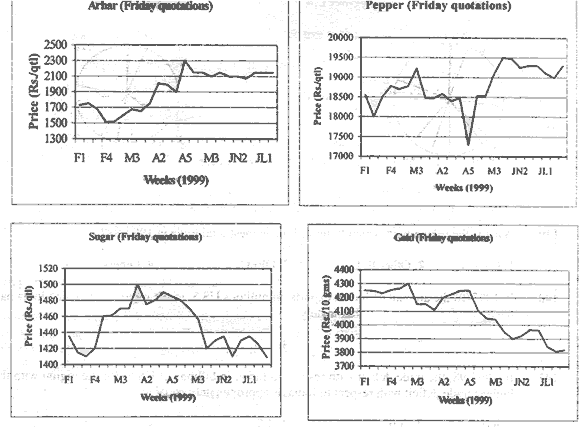
A: U.S.A.
B: Germany
C: Other E.U.
D: U.K.
E: Japan
F: Russia
G: Other East Europe
H: OPEC
I: Asia
J: Other L.D.Cs
K: Others
| Source of Imports |
| 1997-98 Imports into India: $ 40779 million |
1998-99 Imports into India(Apr-Nov.): $ 28126 million |
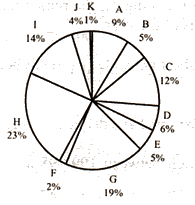 |
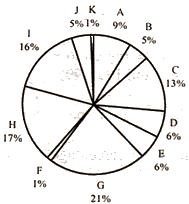 |
| Destination of Exports |
| 1997-98 Exports from India: $ 33979 million |
1998-99 Exports from India(Apr-Nov.): $ 21436 million |
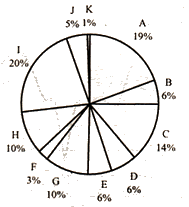 |
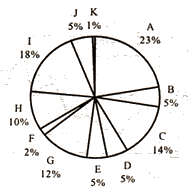 |
139. What is the region with which India had the highest total trade in 1997-98?
1. USA
2. Other E. U.
3. OPEC
4. Others
140. In 1997-98 the amount of Indian exports, in millions US $, to the region with which India had the lowest total trade, is approximately
1. 750
2. 340
3. 220
4. 440
141. In 1997-98, the trade deficit with respect to India, in billions of US $, for the region with the highest trade deficit with respect to India, is approximately equal to
1. 6.0
2. 3.0
3. 4.5
4. 7.5
142. What is the region with the lowest trade deficit with India in 1997-98?
1. USA
2. Asia
3. Others
4. Other E. U.
ADDITIONAL DIRECTIONS for questions 143 and 144: These questions are based on the situation give below:
Assume that the average monthly exports from India and imports to India during the remaining four months of 1998-99 would be the same as that for the first eight months of the year.
143. What is the region to which Indian exports registered the highest percentage growth between 1997-98 and 1998-99?
1. Other East Europe
2. USA
3. Asia
4. Exports have declined, no growth
144. What is the percentage growth rate in India's total trade deficit between 1997-98 and 1998-99?
1. 43
2. 47
3. 50
4. 40
DIRECTIONS for questions 145 to 148: These questions are based on the price fluctuations of four commodities - arhar, pepper, sugar and gold during February - July 1999 as described in the figures below:
145. Price change of a commodity is defined as the absolute difference in ending and beginning prices expressed as a percentage of the beginning. What is the commodity with the highest price change?
1. Arhar
2. Pepper
3. Sugar
4. Gold
146. Price volatility (PV) of a commodity is defined as follows:
PV = (highest price during the period – lowest price during the period) / average price during the period.
What is the commodity with the lowest price volatility?
1. Arhar
2. Pepper
3. Sugar
4. Gold
147. Mr. X, a funds manager with an investment company invested 25% of his funds in each of the four commodities at the beginning of the period. He sold the commodities at the end of the period. His investments in the commodities resulted in:
1. 17% profit
2. 5.5% loss
3. no profit, no loss
4. 4.3% profit
148. The price volatility of the commodity with the highest PV during the Febrauary-July period is approximately equal to:
1. 3%
2. 40%
3. 20%
4. 12%
DIRECTIONS for questions 149 to 153: These questions are based on the table below presenting data on percentage population covered by drinking water and sanitation facilities in selected Asian countries.
Country A is said to dominate B or A > B if A has higher percentage in total coverage for both drinking water and sanitation facilities, and, B is said to be dominated by A, or B < A.
A country is said to be on the coverage frontier if no other country dominates it. Similarly, a country is not on the coverage frontier if it is dominated by at least one other country.
Population Covered by Drinking Water and Sanitation Facilities
Percentage Coverage
|
Drinking Water |
Sanitation Facilities |
| Urban |
Rural |
Total |
Urban |
Rural |
Total |
India |
85 |
79 |
81 |
70 |
14 |
29 |
| Bangladesh |
99 |
96 |
97 |
79 |
44 |
48 |
| China |
97 |
56 |
67 |
74 |
7 |
24 |
| Pakistan |
82 |
69 |
74 |
77 |
22 |
47 |
| Philippines |
92 |
80 |
86 |
88 |
66 |
77 |
| Indonesia |
79 |
54 |
62 |
73 |
40 |
51 |
| Sri Lanka |
88 |
52 |
57 |
68 |
62 |
63 |
| Nepal |
88 |
60 |
63 |
58 |
12 |
18 |
| Source: World Resources 1998-99, p. 25 1, UNDP, UNEP and World Bank |
149. What are the countries on the coverage frontier?
1. India and China
2. Sri Lanka and Indonesia
3. Philippines and Bangladesh
4. Nepal and Pakistan
150. Which of the following statements are true?
A. India > Pakistan and India > Indonesia
B. India > China and India > Nepal
C. Sri Lanka > China
D. China > Nepal
1. A and C
2. B and D
3. A, B and C
4. B, C and D
151. Using only the data presented under Sanitation facilities columns, it can be concluded that rural population in India, as a percentage of its total population is approximately
1. 76
2. 70
3. 73
4. Cannot be determined
152. Again, using only the data presented under Sanitation facilities columns, sequence China, Indonesia and Philippines in ascending order of rural population as a percentage of their respective total populations. The correct order is:
1. Philippines, Indonesia, China
2. Indonesia, China, Philippines
3. Indonesia, Philippines, China
4. China, Indonesia, Philippines
153. India is not on the coverage frontier because
A. it is lower than Bangladesh in terms of coverage of drinking water facilities.
B. it is lower than Sri Lanka in terms of coverage of sanitation facilities.
C. it is lower than Pakistan in terms of coverage of sanitation facilities.
D. it is dominated by Indonesia.
1. A and B
2. A and C
3. D
4. None of these
DIRECTIONS for questions 154 and 155: These relate to the above table with the additional proviso that the gap between the population coverages of sanitation facilities and drinking water facilities is a measure of disparity in coverage.
154. The country with the most disparity in coverage of rural sector is
1. India
2. Bangladesh
3. Nepal
4. None of these
155. The country with the least disparity in coverage of urban sector is
1. India
2. Pakistan
3. Philippines
4. None of these
DIRECTIONS for questions 156 to 165: Each question is followed by two statements, A and B. Answer each question using the following instructions:
Choose 1 if the question can be answered by using one of the statements alone, but cannot be answered using the other statement alone.
Choose 2 if the question can be answered by using either statement alone.
Choose 3 if the question can be answered by using both statements together, but cannot be answered using either statement alone.
Choose 4 if the question cannot be answered even by using both statements together.
156. The average weight of students in a class is 50 kg. What is the number of students in the class?
A. The heaviest and the lightest members of the class weigh 60 kg and 40 kg respectively.
B. Exclusion of the heaviest and the lightest members from the class does not change the average weight of the students.
157. A small storage tank is spherical in shape. What is the storage volume of the tank?
A. The wall thickness of the tank is I cm.
B. When the empty spherical tank is immersed in a large tank filled with water, 20 litres of water overflow from the large tank.
158. Mr. X starts walking northwards along the boundary of a field, from point A on the boundary, and after walking for 150 metres reaches B, and then walks westwards, again along the boundary, for another 100 metres when he reaches C. What is the maximum distance between any pair of points on the boundary of the field?
A. The field is rectangular in shape.
B. The field is a polygon, with C as one of its vertices and A the mid point of a side.
159. A line graph on a graph sheet shows the revenue for each year from 1990 through 1998 by points and joins the successive points by straight line segments. The point for revenue of 1990 is labelled A, that for 1991 as B, and that for 1992 as C. What is the ratio of growth in revenue between 91-92 and 90-91?
A. The angle between AB and X-axis when measured with a protractor is 40 degrees, and the angle between CB and X-axis is 80 degrees.
B. The scale of Y-axis is 1 cm = 1000 Rs.
160. There is a circle with centre C at the origin and radius r cm. Two tangents are drawn from an external point D at a distance d cm from the centre. What are the angles between each tangent and the X-axis?
A. The coordinates of D are given
B. The X-axis bisects one of the tangents.
161. Find a pair of real numbers x and y that satisfy the following two equations simultaneously. It is known that the values of a, b, c, d, e and f are non-zero.
ax + by = c
dx + ey = f
A. a = kd and b = ke, c = kf, k  0 0
B. a = b = 1, d = e = 2, f  2c 2c
162. Three professors A, B and C are separately given three sets of numbers to add. They were expected to find the answers to 1+1, 1+1+2, and 1+1 respectively. Their respective answers were 3, 3, and 2. How many of the professors are mathematicians?
A. A mathematician can never add two numbers correctly, but can always add three numbers correctly.
B. When a mathematician makes a mistake in a sum, the error is + I or -1.
163. How many among the four students A, B, C and D have passed the exam'?
A. The following is a true statement: A and B passed the exam.
B. The following is a false statement: At least one among C and D has passed the exam.
164. What is the distance x between two cities A and B in integral number of Kms?
A. x satisfies the equation log 2 x = 
B. x  10 Kms 10 Kms
165. Mr. Mendel grew one hundred flowering plants from black seeds and white seeds, each seed giving rise to one plant. A plant gives flowers of only one colour. From a black seed comes a plant giving red or blue flowers. From a white seed comes a plant giving red or white flowers. How many black seeds were used by Mr. Mendel?
A. The number of plants with white flowers was 10.
B. The number of plants with red flowers was 70.
End Of Section III
|



